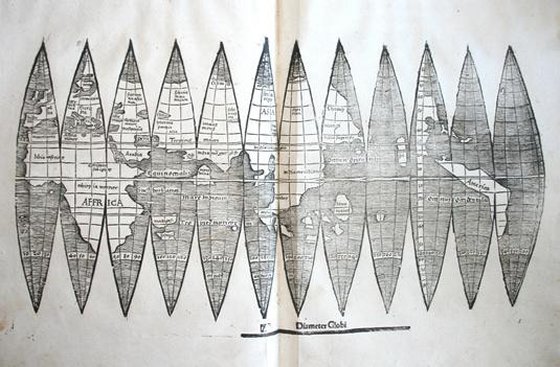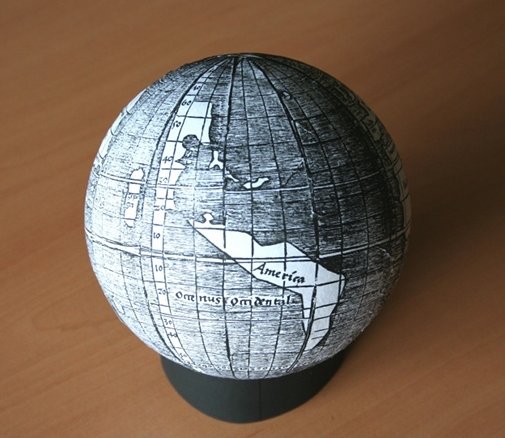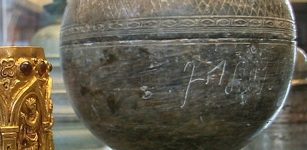Rare Map Reveals The New World As “America” For The First Time
MessageToEagle.com – On this newly discovered unique, ancient map. the New World is mentioned for the first time under the name “America.
The map is rare and it is truly remarkable that it survived the Second World War unscathed.
The American continent was “christened” by the cartographer Martin Waldseemüller.
Now, a previously unknown variant of the famous world map from the mapmaker’s workshop has unexpectedly turned up in the collections in the University Library in Munich.
When Federal Chancellor Angela Merkel officially handed over the famous map of the world printed by Martin Waldseemüller (ca. 1470 — 1522) to the Library of Congress In Washington in 2007, she referred to it as “a wonderful token of the particularly close ties of friendship between Germany and America.”
And indeed, the gesture had great symbolic weight, for the chart — then exactly 500 years old — can be seen as America’s birth certificate.
On this map, the New World appears for the first time under the name “America,” chosen to honor the explorer Amerigo Vespucci (1451 — 1512), whom Waldseemüller erroneously regarded as the discoverer of the continent.
The chart, which is registered in “Memory of the World,” UNESCO’s inventory of the world’s documentary heritage, is now on show in the Library of Congress in Washington.
The map was formerly held in a private German collection, and was included as Object No. 01301 on the list of specially protected German Cultural Treasures, which prohibits their sale and export.
Before the Library could purchase the map from the previous owner and obtain an export license, the object had first to be delisted.
The application to delist was granted at the direction of the Chancellor’s Office in 2001.

The 1507 world map is a wall map, with an area of three square meters. But the much smaller maps, the so-called globe segments, that Waldseemüller also produced were at least as important for the dissemination of geographical knowledge in his own time.
These depict the world in twelve individual segments, or rather surface wedges, which taper to a point at each end and are printed on a single sheet, like cut-outs on construction paper. When correctly arranged, they form a small globe of about 11 cm in diameter. And in the three rightmost wedges, one sees a huge, boomerang-shaped landmass in the middle of an immense ocean.
The globe places America in the remotest West, seen from Europe and Africa, on the far side of a wide, wide sea.
A “packaged tour” of a new world
The wall map was only a part of a carefully designed package put together by the cartographer Waldseemüller and his colleague Matthias Ringmann in their workshop in the monastery of Saint-Dié-des-Vosges — a combination with which they no doubt hoped to revolutionize how the world was perceived. In addition to the large map, the package included an introduction to the principles of geography or “cosmography” (the Cosmographiae Introductio) — and the segmental maps.
Only a handful of the perhaps 100 sets printed from the original woodblocks are known to have survived. The copy now in Washington, which belonged to the princely House of Waldburg-Wolfegg and Waldsee in Germany, is the sole copy of the large world map that has come down to us. A copy of the Cosmographiae Introductio is among the treasures kept in the Munich University Library (MUL).
Four copies of the segmental maps were previously known to researchers. Three of them are now in Minneapolis, Offenburg and in the Bavarian State Library in Munich, respectively. The fourth was sold at auction for the handsome sum of 1 million dollars by Christie’s in 2005. Members of the staff of the University Library have — quite by accident — now discovered a fifth.
See also:
North America Is Named After An Italian Explorer
1833 Map Reveals Americans Lived In A Giant Eagle
Undeciphered Ancient Stone Maps With Mysterious Signs May Hold Key To The Spider Rock Treasure
“The newly discovered sheet differs in a number of details from the copies that were already known, and can therefore be regarded as unique,” says Sven Kuttner, Curator of the Library’s Department of Early Printed Books. For one thing, the outlines of the upper halves of the lanceolate sections are much less distinctively incised.
The position of Calicut on the Malabar Coast, where Vasco da Gama (1469 — 1523) had made landfall in May 1498, is shown on the fourth, not the fifth, segment of the global map. The style of hatching and the forms of certain letters also differ from their counterparts in other copies. Furthermore, according to Kuttner, the watermark impressed in the paper suggests that “this version may have been printed at some time after the first edition of 1507, somewhere in Alsace.”
The time traveler
The “new” Munich copy of the segmented map itself has obviously followed a tortuous course to reach its present haven. And the story of this voyage is at least as fascinating as that of the discovery and exploration of the New World. Its latest chapter began only a few days ago in the Munich University Library. While working on an ongoing revision of the catalogs, a bibliographer came across something quite sensational in an otherwise unremarkable volume that had been rebound in the 19th century.
Tucked in between two printed works on geometry from the early 16th century was the unsought map — a double-page spread in roughly A4 format. The three prints obviously date from the same period, but is there a direct connection between the not entirely disparate subjects? The 19th-century librarians, at any rate, had failed to recognize the significance of Waldseemüller’s map, Kuttner remarks. The first copy of the segmental maps to be discovered only turned up in 1871, in the Hauslab-Liechtenstein Library in Vienna. “And the Munich copy was returned to the obscurity of the stacks.”
But it survived the Second World War unscathed, although the University Library itself was devastated by air raids. In November 1942, large portions of the holdings of older books, including the unassuming volume containing the two geometry treatises, had been transferred to a safer rural location. Stefan Kuttner has ascertained that the book was among the contents of deposit box No. 340, which was first stowed away in Burghausen, and later transported to Niederviehbach near Landshut. The box was returned to Munich in 1955, and provisionally stored in the Northeastern Repository at LMU.

Regrettably, according to Kuttner, the origins of this copy of the segmented world map remain mysterious. One of the works on geometry with which it was bound belonged to the Monastery Library in Oberalteich. The contents of that collection, some 1,400 volumes in all, came into the possession of the University Library, then located in Landshut, during the secularization phase after the break-up of the Holy Roman Empire in 1803.
On the other hand, the map could also be directly related to the copy of the Cosmographiae Introductio in the University Library’s own collection. This is a unique early edition with a two-page colored map of the world, sketched in a rather cursory fashion with pen and ink. It was originally part of the collection assembled by the Swiss humanist and polymath Heinrich Loriti Glareanus (1488 — 1563).
The contents of Glarean’s library were acquired by Johann Egolph von Knöringen (1537 — 1575), a later Bishop of Augsburg, when he was still a student at Freiburg University. In 1573, he stipulated in his will that his books, more than ,6000 volumes in all, were to be donated as an endowment to the University Library of Ingolstadt, the forerunner of the Munich University Library.
“Even in our digital age, the originals have lost none of their significance and unique fascination. Treasures like the newly discovered map can only be brought to light by people who work directly with originals,” says Klaus-Rainer Brintzinger, the Director of the University Library, and adds: “We intend to make the map accessible to the public in digital form in time for the Fourth of July — Independence Day in the USA.”
MessageToEagle.com










